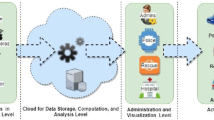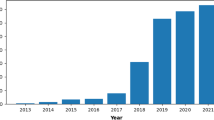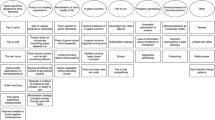Abstract
Trading of Bitcoin is spread about multiple venues where buying and selling is offered in various currencies. However, all exchanges trade one common good and by the law of one price, the different prices should not deviate in the long run. In this context, we are interested in which platform is the most important one in terms of price discovery. To this end, we use a pairwise approach accounting for a potential impact of exchange rates. The contribution to price discovery is measured by Hasbrouck’s and Gonzalo and Granger’s information share. We then derive an ordering with respect to the importance of each market which reveals that the Chinese OKCoin platform is the leader in price discovery of Bitcoin, followed by BTC China. Overall, the exchange rate is neither affected by Bitcoin trading nor does it contribute decisively to its price discovery.



Similar content being viewed by others
Notes
For example, the average daily US Dollar foreign exchange trading volume was 1.65 trillion US Dollar in 2016 as opposed to 14 billion trading of Bitcoin in US Dollar.
We have not interpolated the data in the usual way, keeping the last observation as the still valid one until a change is recorded as we believe that the missing data are due to recording errors, not non-trading. Introducing a day’s worth of zero returns, however, substantially discriminates against the respective platform in terms of price discovery. We, therefore, keep only full-time spans in the spirit of Grammig et al. (2005) who restrict the estimation to overlapping trading hours.
Repeating the analysis using the estimated cointegrating vector leads to almost identical conclusions with respect to the identification of the leadership. More precisely, the leadership results are identical when considering the Hasbrouck (1995) information shares. Considering the Gonzalo and Granger (1995) common factor weights, there is one model (model 11) for which the price discovery leadership is altered.
Detailed VECM estimation results for the remaining models 12–15 are not reported as there are no economic implications that would restrict \(\alpha\) or \(\varPsi (1)\) in the bivariate models.
References
Alberola, E., Lopez, H., Ubide, A. J., & Cervero, S. G. (1999). Global equilibrium exchange rates: Euro, Dollar, "Ins", "Outs", and other major currencies in a panel cointegration framework. https://papers.ssrn.com/sol3/papers.cfm?abstract_id=880830. Accessed 1 Sept 2018.
Baur, D., & Dimpfl, T. (2017). Realized bitcoin volatility. SSRN 2949754, (pp. 1–26).
Baur, D. G., Hong, K., & Lee, A. D. (2018). Bitcoin: Medium of exchange or speculative assets? Journal of International Financial Markets, Institutions and Money, 54, 177–189.
Blanco, R., Brennan, S., & Marsh, I. W. (2005). An empirical analysis of the dynamic relation between investment-grade bonds and credit default swaps. The Journal of Finance, 60(5), 2255–2281.
Bouoiyour, J., & Selmi, R. (2015). What does bitcoin look like? Annals of Economics & Finance, 16(2), 449–492.
Brandvold, M., Molnár, P., Vagstad, K., & Valstad, O. C. A. (2015). Price discovery on bitcoin exchanges. Journal of International Financial Markets, Institutions and Money, 36, 18–35.
Brière, M., Oosterlinck, K., & Szafarz, A. (2015). Virtual currency, tangible return: Portfolio diversification with bitcoin. Journal of Asset Management, 16(6), 365–373.
Cabrera, J., Wang, T., & Yang, J. (2009). Do futures lead price discovery in electronic foreign exchange markets? Journal of Futures Markets, 29(2), 137–156.
Chen, Y. L., & Gau, Y. F. (2010). News announcements and price discovery in foreign exchange spot and futures markets. Journal of Banking & Finance, 34(7), 1628–1636.
Covrig, V., & Melvin, M. (2002). Asymmetric information and price discovery in the FX market: does Tokyo know more about the yen? Journal of Empirical Finance, 9(3), 271–285.
Dimpfl, T., Flad, M., & Jung, R. C. (2017). Price discovery in agricultural commodity markets in the presence of futures speculation. Journal of Commodity Markets, 5, 50–62.
Doguet, J. J. (2012). The nature of the form: Legal ad regulatory issues surrounding the bitcoin digital currency system. La L Rev, 73, 1119.
Dwyer, G. P. (2015). The economics of bitcoin and similar private digital currencies. Journal of Financial Stability, 17, 81–91.
ECB. (2012). Virtual currency schemes. Tech. rep., European Central Bank, Frankfurt am Main, Germany, iSBN: 978-92-899-0862-7 (online).
ECB. (2015). Virtual currency schemes—a further analysis. Tech. rep., European Central Bank, Frankfurt am Main, Germany, iSBN 978-92-899-1560-1 (online).
Engle, R. F., & Granger, C. W. (1987). Co-integration and error correction: Representation, estimation, and testing. Econometrica, 55(2), 251–276.
Gonzalo, J., & Granger, C. (1995). Estimation of common long-memory components in cointegrated systems. Journal of Business & Economic Statistics, 13(1), 27–35.
Grammig, J., & Peter, F. J. (2013). Telltale tails: A new approach to estimating unique market information shares. Journal of Financial and Quantitative Analysis, 48(2), 459–488.
Grammig, J., Melvin, M., & Schlag, C. (2005). Internationally cross-listed stock prices during overlapping trading hours: Price discovery and exchange rate effects. Journal of Empirical Finance, 12(1), 139–164.
Hasbrouck, J. (1995). One security, many markets: Determining the contributions to price discovery. The Journal of Finance, 50(4), 1175–1199.
Hasbrouck, J. (2003). Intraday price formation in us equity index markets. The Journal of Finance, 58(6), 2375–2400.
Hatheway, F., Kwan, A., & Zheng, H. (2017). An empirical analysis of market segmentation on U.S. equity markets. Journal of Financial and Quantitative Analysis, 52(6), 2399–2427.
Johansen, S. (1988). Statistical analysis of cointegration vectors. Journal of Economic Dynamics and Control, 12(2–3), 231–254.
Johansen, S. (1991). Estimation and hypothesis testing of cointegration vectors in gaussian vector autoregressive models. Econometrica, 59(6), 1551–80.
Johansen, S. (1998). Likelihood-based inference in cointegrated vector autoregressive models. Econometric Theory, 14(4), 517–524.
Kroll, J.A., Davey, I.C., & Felten, E.W. (2013). The economics of bitcoin mining, or bitcoin in the presence of adversaries. In: Proceedings of WEIS, vol 2013.
Kwiatkowski, D., Phillips, P. C. B., Schmidt, P., & Shin, Y. (1992). Testing the null hypothesis of stationarity against the alternative of a unit root: How sure are we that economic time series have a unit root? Journal of Econometrics, 54(1–3), 159–178.
Lehmann, B. N. (2002). Some desiderata for the measurement of price discovery across markets. Journal of Financial Markets, 5(3), 259–276.
Li, H., & Maddala, G. S. (1997). Bootstrapping cointegrating regressions. Journal of Econometrics, 80(2), 297–318.
Lien, D., & Shrestha, K. (2009). A new information share measure. Journal of Futures Markets, 29(4), 377–395.
Maeso-Fernandez, F., Osbat, C., & Schnatz, B. (2002). Determinants of the euro real effective exchange rate: A beer/peer approach. Australian Economic Papers, 41(4), 437–461.
Murphy, E. V., Murphy, M. M., & Seitzinger, M. V. (2015). Bitcoin: Questions, answers, and analysis of legal issues. Library of Congress, Congressional Research Service. https://www.davispolk.com/files/congressional_research_service_bitcoin_questions_answers_and_analysis_of_legal_issues.pdf. Accessed 1 Sept 2018.
Nakamoto, S. (2008). Bitcoin: A peer-to-peer electronic cash system. https://bitcoin.org/bitcoin.pdf. Accessed 1 Sept 2018.
Putniņš, T. J. (2013). What do price discovery metrics really measure? Journal of Empirical Finance, 23, 68–83. https://doi.org/10.1016/j.jempfin.2013.05.004.
Rogojanu, A., & Badea, L. (2014). The issue of competing currencies. Case study—bitcoin. Theoretical and Applied Economics, 21(1(590)), 103–114.
Rosenberg, J. V., & Traub, L. G. (2009). Price discovery in the foreign currency futures and spot market. The Journal of Derivatives, 17(2), 7–25.
Segendorf, B. (2014). What is bitcoin. Sveriges Riksbank Economic Review, 2, 71–87.
Stock, J. H., & Watson, M. W. (1988). Testing for common trends. Journal of the American statistical Association, 83(404), 1097–1107.
Trimborn, S., & Härdle, W.K. (2016). CRIX an index for blockchain based currencies. SFB 649 Economic Risk (2016-021). https://ssrn.com/abstract=2800928. Accessed 1 Sept 2018.
Tse, Y., Xiang, J., & Fung, J. K. (2006). Price discovery in the foreign exchange futures market. Journal of Futures Markets, 26(11), 1131–1143.
Velde, F., et al. (2013). Bitcoin: A primer. Chicago Fed Letter (Dec).
Weber, B. (2014). Bitcoin and the legitimacy crisis of money. Cambridge Journal of Economics, 40(1), 17–41.
Xiao, L., Yujian, W., & Qinqin, P. (2017). Chinese bitcoin exchange goes overseas after government shutdown. https://www.caixinglobal.com/2017-12-11/chinese-bitcoin-exchange-goes-overseas-after-government-shutdown-101183710.html. Accessed January 11 2019.
Yan, B., & Zivot, E. (2010). A structural analysis of price discovery measures. Journal of Financial Markets, 13(1), 1–19.
Yermack, D. (2015). Handbook of Digital Currency, Academic Press, chap Is Bitcoin a real currency? An economic appraisal, pp. 31–43.
Acknowledgements
We thank Dirk Baur, Paolo Giudici and the participants of the First Italian Workshop of Econometrics and Empirical Economics for helpful comments and suggestions.
Author information
Authors and Affiliations
Corresponding author
Additional information
Publisher's Note
Springer Nature remains neutral with regard to jurisdictional claims in published maps and institutional affiliations.
Rights and permissions
About this article
Cite this article
Pagnottoni, P., Dimpfl, T. Price discovery on Bitcoin markets. Digit Finance 1, 139–161 (2019). https://doi.org/10.1007/s42521-019-00006-x
Received:
Accepted:
Published:
Issue Date:
DOI: https://doi.org/10.1007/s42521-019-00006-x




